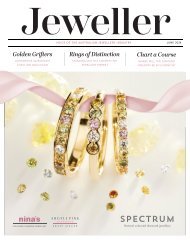Jeweller: The Great Diamond Debate - Round II
Facts Vs Marketing: In 2019, both natural and man-made diamonds battled for the hearts and minds of consumers – and the gloves came off. While the dust is far from settled, the question remains: can consumers really make an informed choice in the midst of a marketing barrage and an increasingly confused industry?
Facts Vs Marketing: In 2019, both natural and man-made diamonds battled for the hearts and minds of consumers – and the gloves came off. While the dust is far from settled, the question remains: can consumers really make an informed choice in the midst of a marketing barrage and an increasingly confused industry?
Create successful ePaper yourself
Turn your PDF publications into a flip-book with our unique Google optimized e-Paper software.
RETAIL SPECIALIST<br />
<strong>The</strong> consumer conundrum: ‘Should I<br />
buy a lab-grown or natural diamond?’<br />
JIMMY DEGROOT’S KEY POINTS:<br />
<strong>The</strong> first question jewellers should ask a customer is, ‘What is important to you in purchasing a diamond?’<br />
Retailers should tailor their sales approach based on the customer’s answer and their attitude to lab-grown diamonds<br />
Lab-grown and natural diamonds appeal to different types of customers as they offer different benefits<br />
<strong>Jeweller</strong>s need to take the lab-grown diamond<br />
market potential seriously. I’m not saying<br />
everyone must dive in with both feet selling labgrown<br />
diamonds – and there is a great range of<br />
opinions on the subject.<br />
But as a jewellery store training specialist, I’ve had<br />
many conversations with jewellers on both sides of<br />
the issue, as well as many in the middle.<br />
Typically customers fall into one of three categories<br />
regarding these diamonds: the customer didn’t<br />
know about lab-grown diamonds until the jeweller<br />
brought it to the customer’s attention, the customer<br />
was aware of them through advertising or social<br />
media, or the customer had done research and was<br />
adamant about buying lab-grown.<br />
<strong>The</strong> first of these customers is typically delighted at<br />
the cost difference between natural and lab-grown<br />
diamonds, which allows them to purchase a larger<br />
diamond with the same budget.<br />
It’s easy to understand the benefits, and when<br />
sticking to their budget is a high priority, they will<br />
likely opt for the lab-grown diamond.<br />
<strong>The</strong> most important question for any jeweller<br />
to ask a customer is, ‘What’s important to you in<br />
purchasing a diamond?’<br />
<strong>The</strong>ir answer will reveal their true desire and the<br />
jeweller can then deliver a product and service to<br />
match the customer’s requirement.<br />
If the customer is aware of the lab-grown product<br />
– but hasn’t done further research – they will<br />
have many questions for the jeweller.<br />
This is good and an important conversation because<br />
it provides the jeweller with the opportunity to<br />
create trust, value and a relationship with the<br />
customer. How the jeweller handles this customer is<br />
key to sales success.<br />
Integrity is key in this conversation. <strong>The</strong> jeweller<br />
should educate the customer, as much as possible,<br />
as to the future value, trade-in potential, and<br />
production processes of lab-grown diamonds.<br />
It’s important, when speaking with this customer,<br />
not to guess or speculate on the future of lab-grown<br />
diamonds, which is ambiguous.<br />
For the customer who is adamant about buying a<br />
lab-grown diamond, the sales conversation should<br />
be straightforward – yet I would still advise retailers<br />
to practise full disclosure regarding the future value<br />
of the diamond.<br />
Again, asking the question, ‘What’s important to<br />
you in purchasing a diamond?’ will confirm the<br />
customer’s desires and priorities, as well as give the<br />
jeweller a comfortable lead-in to the sale.<br />
THE SALES SCENARIO<br />
With more and more shoppers seeking lab-grown<br />
diamonds, it’s important for retailers to know how to<br />
respond – and how to secure the sale.<br />
While it may sound extreme, some US retailers are<br />
exclusively selling lab-grown stones with no natural<br />
diamonds whatsoever.<br />
De Beers’ Lightbox Jewelry – previously an<br />
e-commerce business – is also undertaking a bricksand-mortar<br />
trial with two high-profile US retailers.<br />
Consumers are increasingly becoming aware of<br />
lab-grown diamonds from blogs, social media and<br />
advertising, and the number of consumers who<br />
are passionate about the product is also increasing.<br />
Retailers would be wise to take notice.<br />
For retailers who have recently started stocking labgrown<br />
diamonds – or who are considering doing so<br />
– here are some sales scenarios:<br />
You respond: “I don’t sell lab-grown diamonds”<br />
– If a jeweller asks the key question mentioned<br />
previously – ’What’s important to you?’ – they can<br />
steer the conversation towards how the benefits of<br />
a natural diamond match the customer’s desire.<br />
If the customer wants a ‘big rock’ for the lowest price<br />
possible, and the jeweller does not stock lab-grown<br />
diamonds, an ‘off-make’ diamond may be the only<br />
option. In that situation, the argument of ‘future<br />
value’ does not carry the same weight.<br />
Some jewellers may be afraid of the changing<br />
diamond market. <strong>The</strong> sentiment generally sounds<br />
like this: ‘We don’t know what the value will be in<br />
three years, so how can we give guarantees, tradeins<br />
or buy-backs?’<br />
It’s a very good question – and there’s just cause for<br />
December 2019 <strong>Jeweller</strong> 49


















